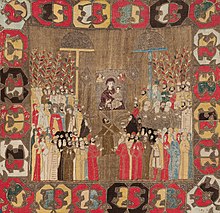Elena of Moldavia
You can help expand this article with text translated from the corresponding article in Russian. (April 2018) Click [show] for important translation instructions.
|
| Elena of Moldavia | |||||
|---|---|---|---|---|---|
| Grand Princess of Moscow | |||||
 Fantasy portrait from the album of the Bucharest National Museum of Antiquities (1904) | |||||
| Princess of Tver | |||||
| Reign | 1485–1490 | ||||
| Monarch | Ivan III | ||||
| Born | c. 1464–1466 | ||||
| Died | 18 January 1505 (aged 39 or 41) Moscow, Russia | ||||
| Burial | Ascension Convent, Moscow | ||||
| Spouse | |||||
| Issue | Dmitry Ivanovich | ||||
| |||||
| House | Mușat | ||||
| Father | Stephen III of Moldavia | ||||
| Mother | Princess Evdochia of Kiev | ||||
Elena Stefanovna of Moldavia (Russian: Елена Стефановна, romanized: Yelena Stefanovna), also known as Elena the Vlach (Russian: Елена Волошанка, romanized: Yelena Voloshanka; c. 1464–1466 – 18 January 1505), was a Moldavian princess as a daughter of Stephen III, who later became the grand princess consort of Moscow in 1483 as the wife of Ivan the Young,[1] the heir of Ivan III of Russia.
After her husband's death in 1490, their son Dmitry Ivanovich was made co-ruler in 1498 until her faction lost in 1502; she and her son were then imprisoned.
Biography

Elena was born in c. 1464–1466. Her parents were Stephen III ("the Great"), the sovereign prince of Moldavia, and his first (or second) wife Princess Evdochia of Kiev.[4][5]
Negotiations to marry her to Ivan Ivanovich ("the Young"), heir to the throne of Moscow, began in the late 1470s.[5] Elena married Ivan the Young on 12 January 1483,[6] and gave birth to Dmitry Ivanovich on 10 October 1483. After the death of her spouse in 1490, her son, who had borne only the title prince,[7] was appointed as the heir to the Russian throne and made co-ruler in 1498.[7] She actively participated in politics at court to protect her son's interests and rights to succession against Sophia Palaiologina, the stepmother of her late spouse, who wished for her son to be appointed heir.[8] The Judaizers, a religious sect in Russia, also found a patron in Elena.[9]
In 1502, the faction of Sophia defeated the faction of Elena. She was transferred to a prison in Moscow with her son, where she was apparently murdered on 18 January 1505.[10][5][7]
References
- ^ Crummey, Robert O. (6 June 2014). The Formation of Muscovy 1300 - 1613. Routledge. p. 94. ISBN 978-1-317-87200-9.
- ^ Flier, Michael; Rowland, Daniel (13 May 2022). Medieval Russian Culture, Volume II. Univ of California Press. p. 222. ISBN 978-0-520-35920-8.
- ^ Ames, Christine Caldwell (2 April 2015). Medieval Heresies. Cambridge University Press. p. 320. ISBN 978-1-107-02336-9.
- ^ Vernadsky, George; Karpovich, Michael (1943). A History of Russia: Russia at the dawn of the modern age, by George Vernadsky. Yale University Press. p. 79.
- ^ a b c "Елена Стефановна". Большая российская энциклопедия (Great Russian Encyclopedia) (in Russian). 28 December 2022.
- ^ Fennell, J. L. I. (1961). Ivan the Great of Moscow. Macmillan. p. 61.
- ^ a b c Bushkovitch, Paul (18 March 2021). Succession to the Throne in Early Modern Russia: The Transfer of Power 1450–1725. Cambridge University Press. p. 57, 61. ISBN 978-1-108-47934-9.
- ^ Treadgold, Donald W. (24 May 1973). The West in Russia and China: Religious and Secular Thought in Modern Times. CUP Archive. pp. 9–10. ISBN 978-0-521-08552-6.
- ^ Angold, Michael (11 June 2014). The Fall of Constantinople to the Ottomans: Context and Consequences. Routledge. p. 131. ISBN 978-1-317-88052-3.
- ^ Tvorogov, Oleg V. (1994). Древняя Русь: События и люди. Sankt-Peterburg: Nauka. p. 101, 102. ISBN 5-02-026015-0.
Sources
- . Brockhaus and Efron Encyclopedic Dictionary (in Russian). 1906.
- Мохов Н. А. Молдавия эпохи феодализма. — Кишинёв: Картя Молдовеняскэ, 1964. — С. 196–197.
- 1505 deaths
- 1465 births
- 16th-century Russian women
- 16th-century Russian nobility
- 15th-century Russian women
- 15th-century Russian nobility
- 16th-century Romanian people
- 15th-century Romanian people
- 16th-century Romanian women
- 15th-century Romanian women
- Russian royal consorts
- House of Bogdan-Mușat
- People from the Principality of Moscow
- Romanian expatriates in Russia
- Romanian people imprisoned abroad
- Russian prisoners and detainees
- Prisoners and detainees of Russia
- Deaths by poisoning
- Assassinated royalty
